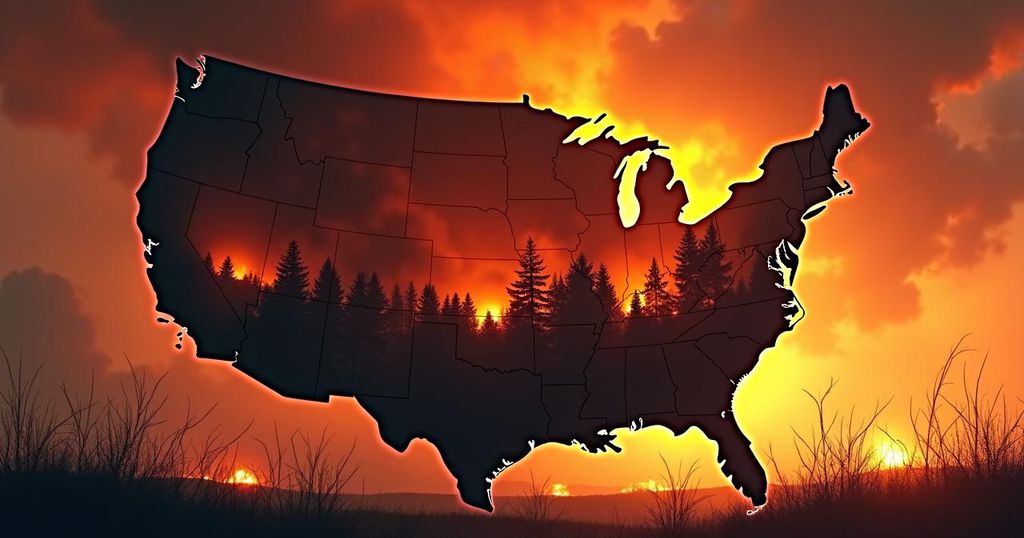The increasing frequency and severity of climate-driven disasters in the United States, such as Hurricane Helene, reveal the vulnerabilities of communities. These storms and natural catastrophes, intensified by climate change, impose enormous economic costs and challenges to aging infrastructures. Notably, areas previously viewed as less susceptible are experiencing unprecedented flooding and destruction, prompting urgent conversations about disaster preparedness and climate adaptation.
In recent years, natural disasters in the United States have surged in frequency and intensity, largely attributed to climate change. Hurricane Helene, which struck Florida and traversed the eastern US, is illustrative of this trend, leading to over 180 fatalities and significant infrastructural damage. Florida’s Big Bend area, previously hurricane-free for decades, has experienced multiple storms within a year, demonstrating the shifting realities of climate impacts. North Carolina has similarly witnessed increased flooding despite being regarded as relatively insulated from the worst effects of climate change. The escalating occurrence of billion-dollar weather disasters in North Carolina has risen sharply from one or two annually between 1980 and 2009 to an average of six or seven today. Concurrently, the state has faced population growth, with nearly 400,000 new residents added since early 2020, exacerbating the consequences of such disasters. The destruction caused by Helene has left many without power or water for an extended period, disrupting communities and claiming lives. Mari Tye, a scientist from the National Center for Atmospheric Research, emphasizes the inadequacies of aging infrastructure designed for a climate that no longer exists. The economic ramifications of such calamities are immense and include not only physical damage but also a decline in economic activity as regions strive to recover. Moreover, the financial toll of these disasters is escalating, with property prices having more than doubled since 2000, thereby increasing the potential for substantial economic impacts from such weather events. Hurricane Helene is projected to be one of the most financially burdensome storms on record, with overall damages estimated at approximately $160 billion across several states. Texas, frequently afflicted by extreme weather, exemplifies the crisis with its record of 186 billion-dollar weather disasters since 1980, resulting in at least $300 billion in damages. Recent events, such as the widespread wildfires and destructive storms in Texas, highlight the state’s vulnerability. The research indicates that climate change is precipitating more severe weather patterns, exacerbated by increased moisture retention within the atmosphere due to rising temperatures. The implications of this include the potential for hurricanes to inflict more damage inland due to their longevity and the higher sea levels exacerbating storm surges. In addition, areas facing drought conditions are increasingly susceptible to wildfires, while the overall heat in the world contributes to more severe heat waves, impacting various sectors, including agriculture and utilities. Daniel Swain, a climatologist, urges a reassessment of preparedness for such extreme weather events, underscoring the importance of recognizing climate change’s significant role in these occurrences. He emphasizes the need for communities nationwide to reflect on their readiness for similar future disasters as a critical aspect of recovery and resilience planning.
The occurrence of extreme weather events has escalated significantly in the United States, highlighting the urgent need to address the impact of climate change on natural disasters. Forecasts of hurricanes and other catastrophes have become increasingly accurate, yet the intensity of these events often leads to unexpected devastation. Florida and North Carolina serve as case studies illustrating the shifting patterns of climate-related disasters, revealing that regions once considered less vulnerable are now facing severe flooding and hurricanes. Further complicating these challenges are the aging infrastructures that struggle to meet modern environmental demands, and the economic implications of such disasters have profound effects on communities, infrastructure, and the economy as a whole. Understanding the dynamics of climate change is essential for formulating effective response strategies.
The rising incidence of climate-fueled storms and natural disasters in the United States, as exemplified by Hurricane Helene, underscores an urgent call to action regarding infrastructure resilience, disaster preparedness, and economic recovery strategies. As climate change continues to exacerbate the frequency and severity of these events, communities across the nation must engage in proactive measures to mitigate risks and adapt to a future where the impacts of climate change are increasingly pervasive. With significant financial burdens and tragic human losses at stake, comprehensive planning and investment in resilient infrastructure and emergency response capabilities are critical to safeguarding the populace and assets of affected regions.
Original Source: www.bnnbloomberg.ca






